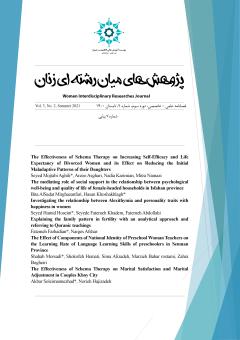-
-
List of Articles
-
Open Access Article
1 - The Effectiveness of Schema Therapy on Increasing Self-Efficacy and Life Expectancy of Divorced Women and its Effect on Reducing the Initial Maladaptive Patterns of their Daughters
Mojtaba Aghili Arezou Asghari mitra namazi -
Open Access Article
2 - The mediating role of social support in the relationship between psychological well-being and quality of life of female-headed households in Isfahan province
Bitaalsadat Mirghazanfari hassan khoshakhlagh -
Open Access Article
3 - Investigating the relationship between Alexithymia and personality traits with happiness in women
seyed hamid Hosseini seyedeh fatemeh khadem fatemeh abdolahi -
Open Access Article
4 - Explaining the family pattern in fertility with an analytical approach and referring to Quranic teachings
فاطمه فرهادیان Narges Afshar -
Open Access Article
5 - The effect of national identity components of female preschool teachers on the level of language learning skills of new learners in Semnan province
Shahab Moradi Shokofeh Hemati Sima Alizadeh Marzieh Bahar rostami Zahara Bogheiri -
Open Access Article
6 - The Effectiveness of Schema Therapy on Marital Satisfaction and Marital Adjustment in Couples Khoy City
Akbar Soleimannezhad Norieh Hajizadeh
-
The rights to this website are owned by the Raimag Press Management System.
Copyright © 2017-2025







